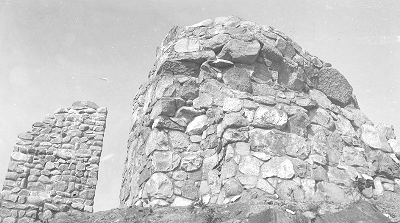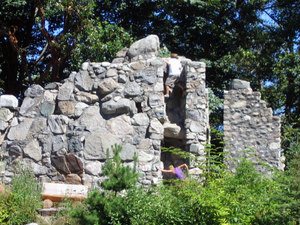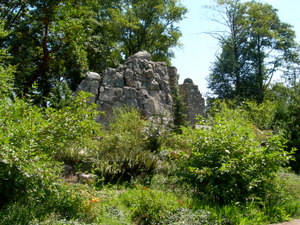 |
Climbing Walls & Other Animals | ||
| Artificial Climbing Structures: Climbing Walls: Climbing Gyms: Bouldering Walls: Lead Climbing Walls: Traversing Walls: Boulders: Mobile Walls: | |||
| HOME: ABOUT US: CLIMBING WALL DIRECTORY FOR SAT NAV - TOPOS FOR CLIMBING WALLS: CONTACT | Contact Us | ||
TOPICS
|
The Schurman Rock is the first artificial Climbing structure or climbing wall known to have been built for the sole purpose of teaching and practising rock climbing and mountaineering. Until this event climbers used building and artificial structures, such as bridges aqueducts and retaining walls. The structure is described as a Polylith, being constructed from rocks and masonry concreted together to form climbing features. As a facility is there is an easy slabby side and a side with difficult climbs. The more difficult side offers the chance to practice different types of climbing, including chimneys and overhanging walls, and belaying an abseiling. Notably missing from the climbing features are jamming cracks, as these didn't become popular until the 1950's. A well as the climbing rock there are also irregular blocks designed to improve balance when moving over rough mountain territory. Perhaps the most incredible feature is the inclusion of a 'concrete glacier' to practice glacier techniques. The Schurman Rock in West Seattle has been the practice ground for some of world's most accomplished mountaineers, including Jim Whittaker, the first American to reach the top of Mount Everest and his twin brother Lou who led the first successful ascent on the north Col of Everest and the legendary Fred Beckey. As well as the tens of thousands of youths that learnt to climb on the structure. |
|||||||
The Rock is located in Camp Long. It was once a little used, 68 acre corner of the West Seattle Golf Course consisting of rough scrub land and bushes. In 1937 Seattle Park Board member, Archie Phelps, Judge William Long, Ben Evans of the Seattle Park Department and Clark Schurman, well known Scout leader, expert mountaineer and wilderness camp developer, embarked on a mission. They wanted to acquire and develop this land to make it into a place for organized scouting groups to learn camping skills. They were joined by a committee of representatives of youth groups, City Council members, other concerned citizens and supportive agencies and councils. Together they worked hard to create Camp Long and protect its natural beauty.
Legacy In the Summer of 1941 two scouts, 12 year old twin brothers Lou and James Whittaker did their first climbs on The Rock. It is said that Clark Schurman designed The Rock so that when the top was reached the summit of Mount Rainer was visible and the aim was then to progress to make a successful ascent of the mountain. The young Whittaker twins caught the climbing bug, and in march 1963 James Whittaker, now a Mountain guide at Mount Rainer, successfully guided Robert Kennedy up the recently named Mount Kennedy. Later that year he went on to make the first American ascent of Mount Everest. Not to be out done, the following year, his brother Lou made the first ascent of the north col of Everest. The route that had taken the life of George Mallory forty years earlier. Located in the heart of a thriving climbing community, this unique rock has enjoyed a long history of use as a practice rock for everyone from individual climbers and hikers to local climbing organizations like The Mountaineers. The Boy Scouts, Girl Scouts, and local youth groups have used it as their practice rock for over fifty years. In addition, the American Red Cross and Seattle Mountain Rescue have used the rock for practices to develop the skills which over the years have been utilized in the rescue of countless people in the state. For 60 years, a great breadth of people enjoyed the rock as an easily accessible place to practice climbing techniques without having to travel far from home. 1999 Closure In the mid 1990's, Schurman Rock began to show significant signs of cracking, possibly as a result of previous settling. In 1999, it was finally declared unsafe and a chain-link fence was installed around the rock. While the Seattle Parks Department values the climbing wall significant asset, it was not scheduled for renovation in the near future because of recent budget cuts and more urgent needs throughout the park system.
Page Acknowledgements and References: Seattle Parks Foundation Seattle Government General Acknowledgements: |
||||||||
|
Material on
this site is all rights reserved -This is a non-commercial, historical
and hopefully educational website. No part of this site may be
reproduced, stored in a retrieval system, or transmitted in any form or
by any means without prior consent. |
||||||||
 Image
© Copyright 1995-2010 City of Seattle
Image
© Copyright 1995-2010 City of Seattle 

